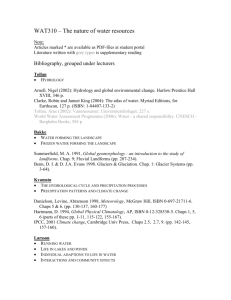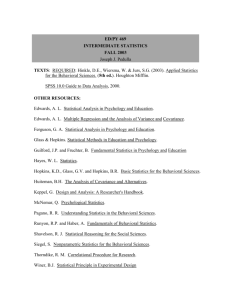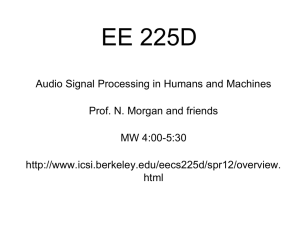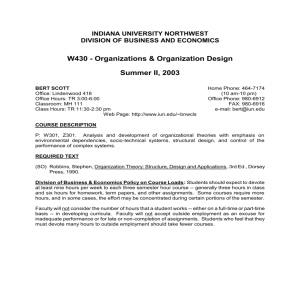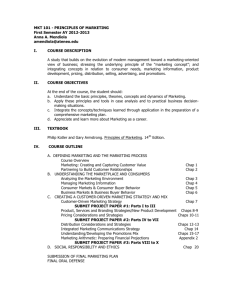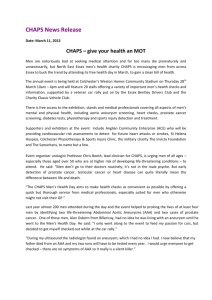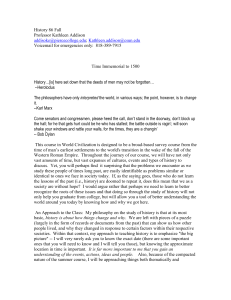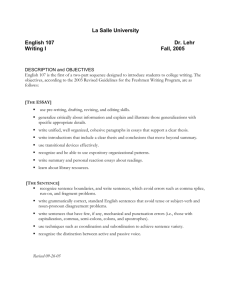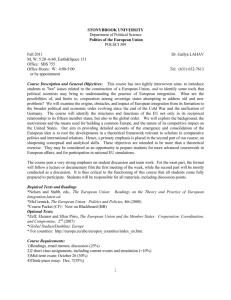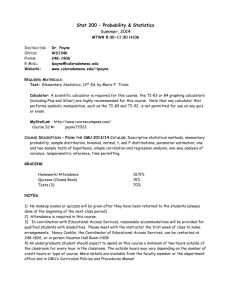ES 358 - nau.edu - Northern Arizona University
advertisement
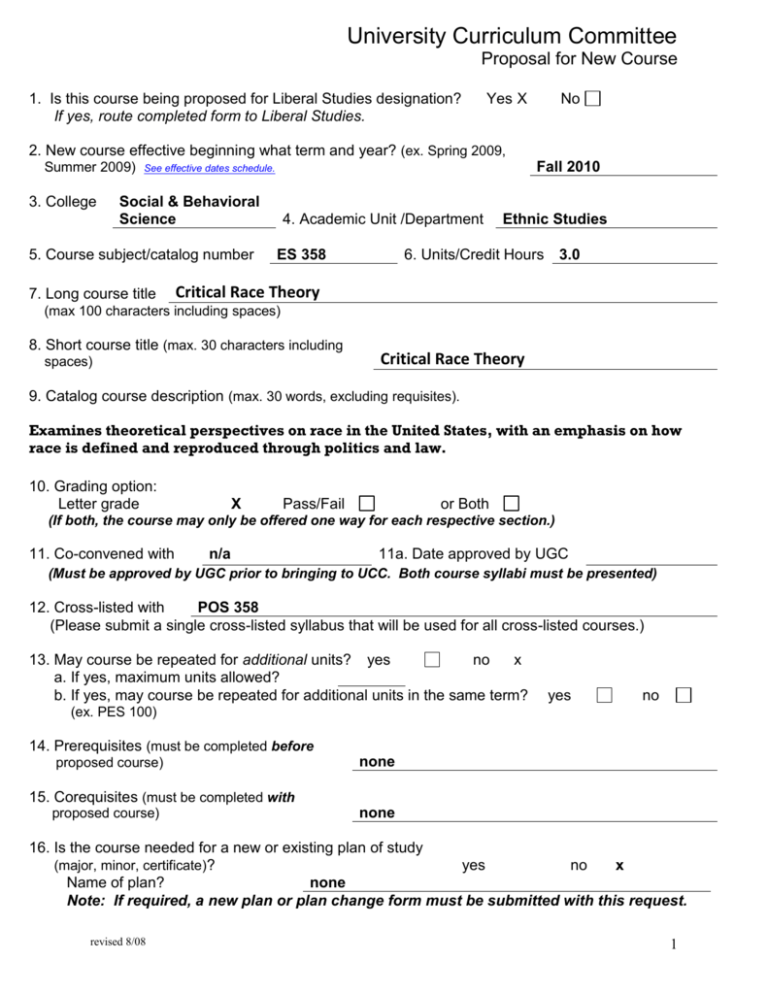
University Curriculum Committee Proposal for New Course 1. Is this course being proposed for Liberal Studies designation? If yes, route completed form to Liberal Studies. Yes X No 2. New course effective beginning what term and year? (ex. Spring 2009, Summer 2009) 3. College Fall 2010 See effective dates schedule. Social & Behavioral Science 5. Course subject/catalog number 7. Long course title 4. Academic Unit /Department ES 358 Ethnic Studies 6. Units/Credit Hours 3.0 Critical Race Theory (max 100 characters including spaces) 8. Short course title (max. 30 characters including spaces) Critical Race Theory 9. Catalog course description (max. 30 words, excluding requisites). Examines theoretical perspectives on race in the United States, with an emphasis on how race is defined and reproduced through politics and law. 10. Grading option: Letter grade X Pass/Fail or Both (If both, the course may only be offered one way for each respective section.) 11. Co-convened with n/a 11a. Date approved by UGC (Must be approved by UGC prior to bringing to UCC. Both course syllabi must be presented) 12. Cross-listed with POS 358 (Please submit a single cross-listed syllabus that will be used for all cross-listed courses.) 13. May course be repeated for additional units? yes no x a. If yes, maximum units allowed? b. If yes, may course be repeated for additional units in the same term? yes no (ex. PES 100) 14. Prerequisites (must be completed before proposed course) none 15. Corequisites (must be completed with proposed course) none 16. Is the course needed for a new or existing plan of study (major, minor, certificate)? yes no x Name of plan? none Note: If required, a new plan or plan change form must be submitted with this request. revised 8/08 1 17. Is a potential equivalent course offered at a community college (lower division only) If yes, does it require listing in the Course Equivalency Guide? Please list, if known, the institution and subject/catalog number of the course 18. Names of current faculty qualified to teach this course: yes yes no no x Joel Olson, Stephen Nuno 19. Justification for new course, including unique features if applicable. (Attach proposed syllabus in the approved university format). One of the curricular emphases for both NAU and the department is to focus on the study of cultural diversity and its role in US public life. This course is an exemplar of that commitment. This course has been taught twice as a special topics course and has received enthusiastic student responses. In addition, this course is intended to fulfill the US ethnic diversity requirement at NAU and is to be cross-listed with POS 358 as endorsed by Politics and International Affairs. For Official AIO Use Only: Component Type Consent Topics Course 35. Approvals Department Chair (if appropriate) Date Chair of college curriculum committee Date Dean of college Date For Committees use only For University Curriculum Committee Date Action taken: Approved as submitted Approved as modified Please attach Syllabus here. revised 8/08 2 ES 358 Critical Race Theory (Sample syllabus) Fall 2010 Class #xxxx MW 2:00-3:15 Du Bois 28 Credit Hours: 3 Dr. Joel Olson, instructor joel.olson@nau.edu Office phone: 523-8514 Office: SBS 236 Office Hours: MWF 11:15-12:30 & by appt. Description of the course Examines theoretical perspectives on race in the United States, with an emphasis on how race is defined and reproduced through politics and law. In particular, it examines the relationship between white supremacy (or “whiteness”) and democracy, as well as intersections between race, class, and gender. The class will examine what race is, how it was formed, how it is related to democratic citizenship, how it has changed over time, and how it functions in the twenty-first century. This is a Liberal Studies course in the Cultural Understanding distribution block: “The mission of the Liberal Studies Program at Northern Arizona University is to prepare students to live responsible, productive, and creative lives as citizens of a dramatically changing world. To accomplish the mission of Liberal Studies, Northern Arizona University provides a program that challenges students to gain a deeper understanding of the natural environment and the world’s peoples, to explore the traditions and legacies that have created the dynamics and tensions that shape the world, to examine their potential contributions to society, and thus to better determine their own places in that world. Through the program students acquire a broad range of knowledge and develop essential skills for professional success and life beyond graduation.” This course contributes to this mission by helping to understand the world’s peoples and their diversity. It engages students in the study of the racial patterns that characterize the history of human communities in the United States. In addition to learning about political ideologies, this course will emphasize effective writing, an essential skill defined in the University’s Liberal Studies Program. Prerequisites: None. Books The following books are required for the course: Patricia Hill Collins, Black Sexual Politics (Routledge 2004) Thomas Sowell, Black Rednecks and White Liberals (Encounter Books 2005) W.E.B. Du Bois, The Souls of Black Folk (Dover 1994) Charles Mills, The Racial Contract (Cornell University Press 1997) Noel Ignatiev, How the Irish Became White (Routledge 1995) Andrea Smith, Conquest (South End Press 2005) Ian Haney López, Racism on Trial: The Chicano Fight for Justice (Belknap 2004) The following book is optional: Joel Olson, The Abolition of White Democracy (University of Minnesota 2004) revised 8/08 3 The total cost of the required books is about $90 new. There are also a number of articles assigned. They are available at the course web site. Course web site: http://vista.nau.edu Much of the course content (assignments, syllabus, roundtable teams, readings, links for further study, etc.) is available on Blackboard Vista. This course will show up when you go to http://vista.nau.edu and log on. You will be checking this site regularly. Attendance policy This is a course on political, legal, and social theory. Theory is a participatory subject. It is learned not only by reading and writing but also through discussion and debate. For this reason, attendance is important. As you would with any other missed appointment, call or email me if you will be absent for a class. You are responsible for all material missed due to absences. Student Learning Expectations By the end of the course you will be able to: Define race Compare and contrast various theories of race and racialization Evaluate the role of race in American politics and law from the colonial era to the present, particularly in the construction of American citizenship Analyze the nation’s diversity and the intersections of race, class, and gender Appraise the role and function of race in the twenty-first century Compare and contrast the arguments of the texts assigned Think critically and articulate your own theory of race and democracy, and compare it to others Assignments 1. A 5 page paper, due February 25 (50 points) 2. A 6 page paper, due April 2 (60 points) 3. A 12-15 page research paper, due May 7 (75 points) 4. A presentation of your research paper, due April 28-May 7 (25 points) 5. Weekly response papers and briefs (20 points) 6. Two roundtables (10 points) 7. Two presentations of “racial moments” (10 points) There are no exams. • Grade Scale Total points possible for the course: 250. Final grades will be determined according to the following: 225-250 points = A, 200-224 = B, 175-199 = C, 150-174 = D, 149 or below = F. • Effective writing: One of the purposes of this class is to teach you how to write well. We’ll spend some time in class on how to write an argumentative essay. The three assigned essays will cover course material; outside sources are not required. Grading of essays is based on the following five criteria: 1) That your paper has a thesis. A thesis consists of three elements: it introduces the topic, it answers the essay question clearly, and it tells the reader how the thesis is going to be defended, indicating what reasoning or evidence will be used in the body of the paper. revised 8/08 4 2) That the paper is well organized and easy to understand. The recommended format is thesis-body-conclusion. 3) That you make an original, persuasive argument based on your beliefs and what you’ve learned from the texts and lectures. 4) That you back up your claims with evidence from the texts. This means you will have to explain the arguments as well as offer your analysis of them. I want to know what you think, but I also want to know how the things you’ve read support your argument. 5) That your paper is typed and is the required length (double-spaced, regular margins). Please don’t bother with fancy covers or folders—they’re a pain. Please put page numbers on your paper. We will go over all of this in more detail later in the semester. • Late papers: Please contact me in advance if you anticipate problems turning in your papers. Otherwise, late papers will be marked down one grade. • Response papers and briefs: Every week (except weeks with papers and presentations due) you will turn in a response paper or a brief. Response papers are a one-page response (typed, handwritten, or submitted to Vista) to the reading. The purpose of response papers is to help you understand the main argument of the text and develop your criticisms of it. For each response paper, discuss the a) main argument, b) strengths, and c) weaknesses of the reading. Feel free to compare the text to previous texts we’ve read as well. Briefs are a 1-2 page (typed only) summary and analysis of a Supreme Court decision. Each brief contains the name and date of the case, the facts of the case, the vote, a summary of the majority’s opinion and reasoning, and a summary of the arguments of other opinions (concurring or dissenting). Instructions on how to write a brief are available on the course web site. Each response paper and brief is worth 2 points. I will count your best 10 out of a possible 12 response papers or briefs for the whole semester, for a total of 20 points. No late response papers or briefs accepted. • Plagiarism: If you plagiarize any part of your essays or response papers or briefs, you will fail the course. Plagiarism means the deliberate use of someone else’s language, ideas, or other original material (i.e. material that is not common knowledge) without acknowledging the source. • Roundtables: Each person will participate in two roundtables. A roundtable is a small group that leads class by presenting the key issues of a text, discussing its significance, and facilitating class discussion. The total possible points for each roundtable is 5, or 10 points for the semester. Missed roundtables cannot be made up without prior arrangement. • Racial moments: This is something like racial show and tell. Twice during the semester you will make a very brief (5 minutes tops) presentation on something you have observed that illuminates the role of race in the media, popular culture, politics, economics, education, or any other sphere of life. This could include things such as newspaper clippings, movie or music reviews, magazine images, etc. I encourage you to bring the item to class if possible. You can do this at any time during the semester (except during presentations at the end of the semester) and you don’t have to schedule it in advance; just let me know at the beginning of class that you have a racial moment to present. I welcome partnered or group presentations. Each racial moment is worth 5 points, for a total of 10 points. • Course content may vary from this outline to meet the needs of this particular group. revised 8/08 5 • Please turn off all cell phones and other electronic devices when in class. Laptops are permitted for note taking and other classroom uses, but not for surfing the web or “multitasking.” If you use your laptop for purposes outside of this course, I will prohibit you from bringing it to class. • Safe Working and Learning Environment Policy: Safe Working and Learning Environment, Students with Disabilities, Institutional Review Board, and Academic Integrity policies all apply to this course. These policies are available at http://www4.nau.edu/diversity/swale.asp. • Evacuation Notice: In the event of an alarm, you must leave the building immediately by the nearest exit, and move away from the building. Do not use the elevators. Please help those who may need assistance in exiting. COURSE OUTLINE AND SCHEDULE OF READINGS Please have the day’s assignment read before class. Your ability to participate and do well in the class depends on staying caught up on the readings. (V) = Available on Vista. (Click on the “Course readings” link.) Date Topic Reading I. Introducing the problem of race in the 21st century January 14 16 21 23 28 30 4 February 6 revised 8/08 Patricia Hill Collins, Black Sexual Politics Introduction (pp. 1-18), chaps. 1, 2 Martin Luther King Jr. Day NO CLASS Collins chaps. 3 and 4 or 5 Thomas Sowell, Black Rednecks and White Liberals pp. 1-63 II. Race as a political concept Jared Diamond, “Race without Color” (V) Lynn Jord and Stephen Wooding, “Genetic Variation, Classification, and ‘Race’” (V) S.O.Y. Keita et al., “Conceptualizing Human Variation” (V) Edmund Morgan, “Slavery and Freedom: The American Paradox” (V) Optional: Olson, Abolition of White Democracy Introduction, chap. 1 W.E.B. Du Bois, Souls of Black Folk chaps. 1, 3, 4, 13, 14 W.E.B. Du Bois, Dusk of Dawn chaps. 5 & 6 (V) 6 Date Topic Reading 11 Charles Mills, The Racial Contract Introduction, chap. 1 13 Mills chap. 2 18 Mills chap. 3 Roundtable on race as a political concept III. Immigration and white citizenship 20 U.S. Constitution (V) Dred Scott v. Sandford 60 U.S. 393 (1857) [edited version] (V) 25 Noel Ignatiev, How the Irish Became White Introduction, chaps. 1-2 FIRST PAPER DUE 27 Ignatiev chaps. 3-4 March 3 Ignatiev chaps. 5-6 Rochmes and Griffin, “The Cactus that Must Not Be Mistaken for a Pillow” (V) Optional: Olson chap. 2 Roundtable on immigration & white citizenship IV. Racial identities and struggles for power 5 10 Michael Rogin, “Liberal Society and the Indian Question” (V) Andrea Smith, Conquest Introduction, chap. 1 12 Smith, Conquest chaps. 2-4 March 17-21 SPRING BREAK 24 Smith, Conquest chaps. 6, 7 (pp. 137144, 152-175), 8 Smith, “Heteropatriarchy and the Three Pillars of White Supremacy” (V) 26 Brown v. Board of Education 347 U.S. 483 (1954) (V) Brown v. Board of Education II 349 U.S. 294 (1955) (V) March 31 April 2 revised 8/08 13th, 14th, 15th Amendments of the Constitution (V) Plessy v. Ferguson 163 U.S. 537 (1896) (V) Ian Haney López, Racism on Trial Prologue, Introduction, chaps. 1, 2 López chaps. 3, 5, 6 (skim) 7 Date Topic 7 Reading SECOND PAPER DUE López chaps. 7, 8 (skim), 9, Epilogue (pp. 236-239, 249-250) Rodolfo “Corky” Gonzales, “I Am Joaquín/Yo Soy Joaquín” (V) Roundtable on racial identity and power V. Race in the 21st century April 9 14 Gratz v. Bollinger 539 U.S. ___ (2003) (V) Grutter v. Bollinger 539 U.S. ___ (2003) (V) 16 Collins chaps. 6, 8 21 Collins chap. 9, Afterword Sowell pp. 203-245 23 Sowell pp. 247-291 Optional: Olson chap. 4 Roundtable on race in the 21st century 28 Presentations 30 Presentations May 7 revised 8/08 University of California Regents v. Bakke 438 U.S. 265 (1978) (V) Final Exam (12:30-2:30) Optional: Olson chap. 5 Presentations Roundtable on critical race theory (Attendance is required) THIRD PAPER DUE No final exam 8
